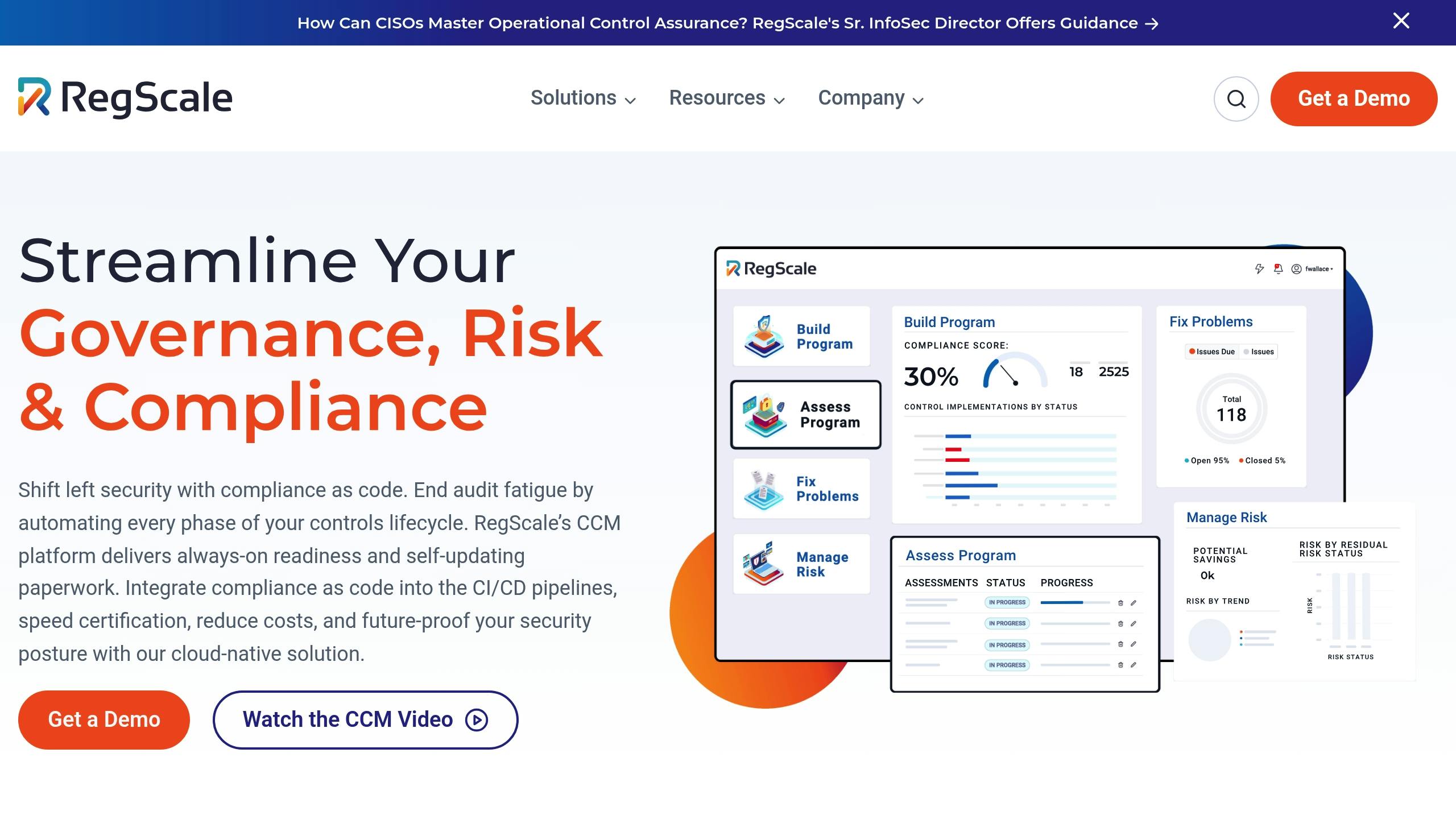Struggling with DORA compliance? Automation can simplify it. The Digital Operational Resilience Act (DORA) sets strict rules for EU financial institutions to manage ICT risks, report incidents, and ensure operational stability. Manual processes are error-prone and resource-intensive, but automation offers a solution.
Key Takeaways:
- DORA Requirements: Focus on ICT risk management, incident reporting, resilience testing, and third-party oversight.
- Automation Benefits: Reduces errors, saves time, and improves compliance efficiency by up to 60%.
- Top Tools: ICT risk platforms, SIEM systems, and automated testing tools align with DORA's needs.
- Choosing Software: Look for regulatory coverage, scalability, and integration features.
Quick Comparison:
| Key Area | Automation Potential | Example Tools |
|---|---|---|
| ICT Risk Management | High | Risk assessment platforms |
| Incident Reporting | Very High | SIEM systems |
| Resilience Testing | High | Automated testing tools |
| Third-Party Oversight | Medium | Vendor management tools |
Next Steps: Implement real-time monitoring, automate risk assessments, and streamline reporting workflows. By 2025, AI and cloud-native tools will dominate compliance strategies, making DORA easier to manage.
DORA Requirements and Automation Options
Main DORA Compliance Areas
DORA's core requirements can benefit significantly from automation in these five key areas:
| Key Requirements | Automation Potential |
|---|---|
| Continuous risk assessment and monitoring | High - automated scanning and real-time monitoring |
| Automated detection/classification and EU-wide reporting templates | Very High - automated detection and classification |
| Regular vulnerability assessment | High - automated testing and scheduling |
| Vendor risk monitoring | Medium - automated assessment tools |
| Threat intelligence exchange | High - automated data collection and distribution |
Tasks That Can Be Automated
Automation plays a crucial role in meeting DORA's operational resilience goals. It not only reduces compliance costs - by as much as 60% - but also enhances accuracy [2].
Here are some real-world examples of automation's impact:
-
ICT Risk Management Platforms
A German insurer reported an 80% improvement in vendor risk identification speed by using automated third-party assessment tools, aligning with DORA's oversight requirements [1]. -
SIEM Systems
A French company cut its audit preparation time by 65% through automated documentation processes [1]. -
Automated Testing Tools
These tools handle scheduling and execution of vulnerability scans, providing full audit trails for compliance.
Matching Requirements to Software Tools
Specific software solutions can address DORA's requirements effectively:
-
ICT Risk Management Platforms
These platforms offer continuous monitoring and automated risk scoring, helping organizations stay ahead of potential issues. -
SIEM Systems
Security Information and Event Management tools provide real-time detection of incidents and automated reporting, streamlining compliance efforts. -
Automated Testing Tools
These tools ensure regular vulnerability assessments and penetration testing, with scheduled executions for consistent coverage.
RegCover: The Future of Compliance Automation

sbb-itb-107f699
How to Choose DORA Compliance Software
The DORA compliance software market is expected to hit $2.3 billion by 2025 [3]. Making the right choice requires careful consideration.
Key Features to Look For
When assessing software, focus on features tied to DORA's five pillars:
| Feature Category | Key Components |
|---|---|
| ICT Risk Management | Vulnerability scanning |
| Incident Response | Real-time detection, standardized EU reporting |
| Resilience Testing | Penetration testing, scenario-based testing, results analysis |
| Third-Party Management | Vendor assessment, contract tracking, performance monitoring |
| Information Sharing | Secure data exchange, threat intelligence integration |
Opt for solutions that scale easily, include built-in audit trails, and integrate with your existing systems. These features are crucial for automating processes, as seen in examples from institutions in Germany and France.
Comparison Guide for Software
Match your evaluation criteria with the automation needs identified in your organization's risk assessments:
| Evaluation Criteria | Weight | What to Look For |
|---|---|---|
| Regulatory Coverage | 30% | Full mapping to DORA requirements |
| Integration Capabilities | 25% | API support, compatibility with existing systems |
| Scalability | 20% | Ability to grow with your organization |
| User Experience | 15% | Easy-to-use interface, minimal training required |
| Support & Updates | 10% | Responsive support, regular updates |
DORApp: A SaaS Solution for DORA Compliance

Platforms like DORApp offer a comprehensive approach to compliance by combining multiple features into a single solution:
-
XBRL Reporting Automation
Simplifies the creation of DORA-compliant reports through automated data integration. -
Integrated Risk Management
Includes automated risk assessments and third-party vendor management, available with the Enterprise plan (200 EUR/user/month). -
Enhanced Security and Audit Features
Offers multi-factor authentication, IP filtering, and geo-fencing while adhering to GDPR and ISO27001 standards. These measures align with DORA's audit trail requirements.
DORApp's cloud-based platform minimizes complexity with automatic regulatory updates and seamless API integrations, keeping your organization aligned with the latest DORA standards.
Setting Up Automated Compliance Systems
Integration Steps
To automate compliance with DORA effectively, a well-structured implementation process is key. After selecting suitable software (refer to Section 3 for criteria), follow this phased approach:
| Phase | Duration | Key Activities |
|---|---|---|
| Planning | 4-6 weeks | Map data flows, evaluate legacy systems |
| Initial Setup | 8-10 weeks | Establish APIs, set up access controls |
| Core Integration | 10-12 weeks | Configure workflows, implement validation rules |
| Full Deployment | 6-8 weeks | Train staff, execute phased rollout |
A great example comes from ING Bank. Their Chief Compliance Officer, Maria van der Berg, shared: "We automated 85% of ICT risk assessments, cutting processing time from three weeks to just three days" [4]. This streamlined process aligns with DORA's focus on continuous risk monitoring and quick incident response.
System Testing
Thorough testing is essential to ensure automated compliance systems perform reliably. A combination of testing methods works best:
- Data Validation Testing: Ensures the accuracy of compliance reports.
- Integration Testing: Verifies seamless system connections.
- Security Testing: Confirms adherence to DORA's cybersecurity standards.
- Performance Testing: Evaluates how the system handles high-stress scenarios.
Financial software providers have shown that robust testing strategies can cut post-deployment issues by 75% [4]. Scenario-based testing, in particular, is highly effective for assessing ICT risk management and incident reporting capabilities.
Performance Tracking
Tracking the success of automation requires clear metrics and consistent reviews. Focus on these key performance indicators (KPIs):
| Metric | Target | Result |
|---|---|---|
| Compliance Task Completion | 95% | 60% improvement |
| Error Rate Reduction | <1% | 30% fewer audit findings |
| Response Time | <4 hours | 65% faster incident detection |
| Cost Efficiency | 30% savings | €2.7M annual reduction |
Quarterly reviews have proven effective for many financial institutions, leading to a 25% yearly boost in compliance efficiency and a 15% drop in false positives for risk detection [4].
Conclusion
Action Steps
Based on the steps discussed earlier, here are the key automation initiatives to focus on:
| Priority | Action |
|---|---|
| Critical | Implement real-time ICT risk monitoring |
| High | Automate third-party assessments |
| Essential | Deploy standardized reporting workflows |
What's Next for Compliance Software
The tools and examples covered earlier highlight three trends that will shape the future of compliance automation. By 2025, 78% of financial institutions are expected to boost their investment in this area [2]. AI-powered risk assessment tools will play a major role, enabling organizations to identify threats before they escalate, building on the platforms already discussed.
Key advancements to watch for in 2025 include:
- AI-driven risk detection systems for smarter threat identification.
- Blockchain-based audit trails for improved transparency and security.
- Cloud-native compliance platforms that offer scalable automation.
These technologies will help financial institutions stay compliant while also gaining valuable insights to strengthen their operations.
| Technology Trend | Impact |
|---|---|
| AI Risk Analysis | Better threat detection |
| Blockchain Audit Trails | Greater transparency |
| Cloud-Native Solutions | Scalable and automated testing |


